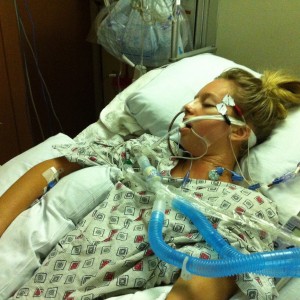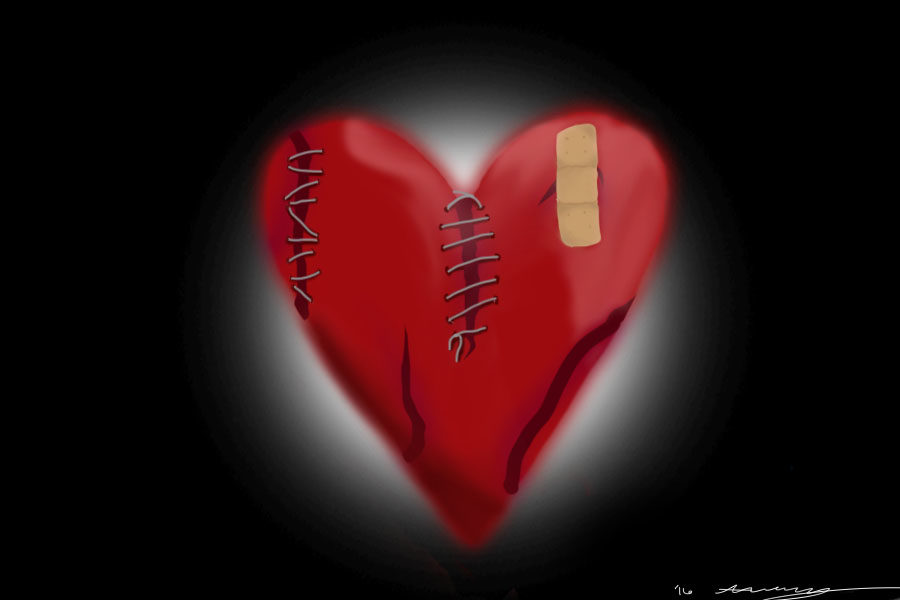February marks heart disease awareness month, with students encouraged to wear red on Friday, Feb. 5.
Painted red for heart health
Former student shares story of life-threatening incident as February awareness month begins
February 3, 2016
Sept. 4, 2013 started normally for Meghan Hancock.
The then-sophomore at Abilene Christian University began her day by waking up early for her 8 a.m. fitness wellness class and eating some oatmeal. Once she arrived at class, she was assigned to do a 12-minute jog around the 200 meter indoor college track.
The day was still normal.
She jogged around the track seven times, but on the eighth lap something went wrong.
The day was no longer normal.
“I was about nine and a half minutes into the jog, and I stopped, put my hands on my knees, and then fell on my back,” the former Lovejoy student said.
The people in the facility watching Meghan jog ran over to her as soon as they saw her collapse and immediately noticed that her heart had stopped beating.
“One of the boys, James, was a lifeguard and started CPR,” Meghan said. “One of the girls, Molly, working the front desk called 911 then came to help James with CPR. James and Molly had been doing CPR for about five minutes when the paramedics arrived and took over.”

Lovejoy alumni Meghan Hancock was placed into a medically-induced coma in 2013 after experiencing sudden heart failure.
The paramedics delivered three shocks to her heart to get it started again. She received three more shocks after being put into the ambulance. Once she arrived at the Hendrick Medical Center in Abilene, the doctors there decided it would be best to put Meghan in a coma to protect her organs.
“Meghan’s blood pressure, heart rate, and temperature were up and down in extreme,” Meghan’s mom and former Lovejoy employee Stacey Hancock later wrote on the Facebook page entitled Praying for Meghan. “To control it, the doctor put her in a medically-induced coma, and she was admitted into the Critical Care Unit. Shortly after that Meghan was put on a cooling system to bring her body temperature to 34 degrees Celsius. This was the best way to preserve her brain.”
Six days after the incident doctors slowly began to awake Meghan from her coma. The next two weeks were filled with frustrations and bad news.
“I didn’t understand what was going on, and I was learning how to talk, walk, write, and eat all over again,” Meghan said. “I felt like a 2 year old in a 19 year old body. Then [the doctors] gave me the news I couldn’t go back to school.”
Toward the end of her hospital stay of a total of 22 days, Meghan went into surgery so that a defibrillator could be implanted into her chest. The defibrillator shocks her heart whenever her heart starts to fail, and actually went off the summer following her hospital release.
“Doctors didn’t have an answer for me of why my defibrillator went off,” Meghan said. “I did have a surgery where they froze some parts around my heart that [the doctors] thought had caused my defibrillator to go off.”
The biggest mystery regarding Meghan’s incident is the actual cause of the incident. Currently Meghan’s incident is labeled as “heart failure,” and as of right now doctors are unable to pinpoint the abnormal activity in her heart that caused her heart to stop.
WEARING RED
The cause of Meghan’s experience could be a wide range of conditions or diseases including heart disease which covers a variety of heart abnormalities. February is the month dedicated to learning about heart disease and signs of heart abnormalities, and students and faculty are encouraged to wear the color red on Feb. 5 in acknowledgement of the disease.
High school nurse Jeannie Haines has advanced certification and practice in cardiac medicine and enjoys informing others about the topic of heart disease.
“[Heart disease] starts with the plaque that builds up in our arteries, and plaque can form clots,” Haines said. “It narrows the artery, narrows the vessel, that oxygenated blood is being pumped through.”
Heart attacks, strokes, and others events alike, all stem from this cardiovascular disease.
“Our heart has an artery that feeds the myocardium [heart muscle], so when there’s a problem in those arteries we end up with someone having a heart attack,” Haines said. “If there is a situation where an artery or vessel becomes clogged or shut off or has a bleed and it’s in the brain, it’s a cerebral vascular accident and a stroke.”
Most kids and teenagers shouldn’t be concerned with contracting heart disease any time soon, as heart disease is extremely rare in younger populations. Meghan’s incident was such a rarity that it’s still unknown whether or not it was heart disease-related.
“The good news is that the majority of students are nice and healthy,” Haines said. “They haven’t had time to wreck their arteries over time like adults have. For students, it’s all about developing good nutrition, a healthy eating pattern, so that right from the get-go you are working to keep those arteries really, really nice and healthy.”
TECH TREATMENTS
Student athletes have an increased chance of a seeing a heart abnormality due to their chosen sport. No Lovejoy athlete has experienced a heart abnormality during a game or practice, but there are always Automated External Defibrillators (AEDs) nearby in the instance that one would occur.
Additionally, electrocardiograms (ECGs or EKGs) from the Cypress ECG Project, which recently merged with Who We Play For, are now offered as an optional portion of the sports physical. These are highly recommended for those who have a heart condition in their blood line.
“[The electrocardiogram] is testing electrical activity from the heart, and different heart conditions will cause that ECG or EKG to look differently on the print out,” athletic trainer Susan Smiley said. “The peaks and valleys will be wider, shorter, deeper, narrower, and that tells you what might be wrong with your heart.”
Although electrocardiograms can produce false positives and might not recognize certain heart conditions, conditions in Lovejoy students have been found.
“With our volunteer ECG testing, we have had children that we have found conditions in that needed surgery,” Smiley said.
Meghan’s family members must be tested with an EKG each year because it is undetermined whether or not Meghan’s heart failure was hereditary.
“We all had to get tested, and we have to get tested every year,” Meghan’s brother and junior Beau Hancock said. “Mine came back a little bit off a couple times, but [the doctors] said it was nothing serious.”
RAISING AWARENESS
Haines used the phrase, “know your numbers, don’t smoke, eat healthy, and move more,” to discuss ways to prevent and manage heart disease for people in all age groups.
“Everyone needs to know what their cholesterol and triglyceride levels are,” Haines said. “The other thing is knowing what your blood pressure is because hypertension is one of those big factors for heart disease. And I really got to put a plug in for not smoking. That is so hard on the vascular system and body’s ability to really oxigenate well.”
Students and faculty with questions regarding heart disease are offered a variety of information outlets.
“There is so much good information that’s available,” Haines said. “The American Heart Association is one place that I always would recommend. I would guess they really are the leaders in research or one of the top leaders in research of heart disease. Part of their mission is education and helping people learn how to hopefully prevent getting to the point to having heart disease.”
MOVING FORWARD
Following her incident and with a lack of closure, fear will always linger for Meghan.
“Anytime I am running or playing a sport, in the back of my mind, I am scared that my heart will stop or my defibrillator will shock me,” Meghan said.
Although Meghan’s incident had its negative impacts, like delaying her college career by one semester, she has come to terms with the good things that have come from the situation.
“I now treasure my life and the time I have with others,” Meghan said. “God has given me a second chance at life, and I want to live my life to the fullest. I have learned that life is so special and to have people in your life that are going to make you feel special.”

sarah hancock • Feb 3, 2016 at 2:25 pm
this is our precious granddaughter. she has returned to ACU to finish her degree. So thankful to God for spraing her life. Love to our Meghan
Stacey • Feb 3, 2016 at 1:57 pm
THANK YOU, Sydney Wong, for a beautifully written article about Meghan! It brought tears to my eyes… the good kind. It was a wonderful reminder of how precious life is and how we almost lost Meghan that day.
And how grateful I am for the students who knew CPR that day, they are the reason Meghan is here with us today!
Thank you for writing this story!